We often dream of traveling to other worlds, but what if space is your world? What if the ship you live on and the walls that contain you are the only society you’ve ever been exposed to? Science fiction is full of great big rockets that function like planets—transplanting the best and often the very worst of their homeworlds to the stars—and shepherd civilizations among the stars. Here are some of the most thought-provoking examples that we can’t stop wondering about.
Starship UK — Doctor Who
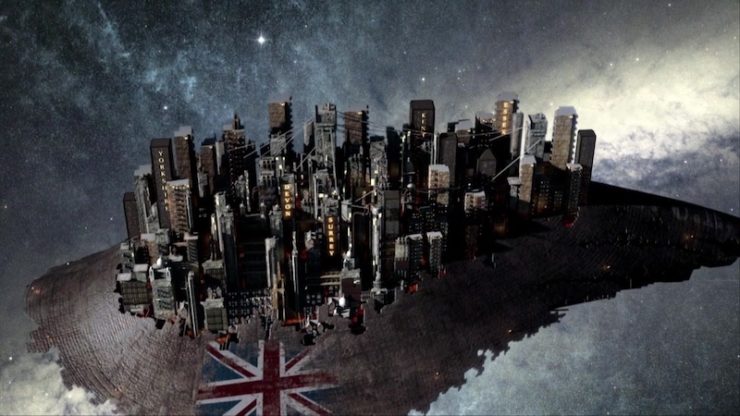
The fifth season episode “The Beast Below”, saw the Doctor and Amy on their first proper adventure, forward into the future to a ship known as Starship UK. In the 29th century the Earth was threatened by solar flares, but the entirety of the United Kingdom (minus Scotland, who wanted their own ship) could not manage to make an escape to space. A star whale appeared, and the humans captured it and built their ship around the whale. Never expecting that the endangered whale was offering assistance freely, humans needlessly tortured the star whale for generations as the ship’s engine, with every human adult getting to vote on the whale’s continued enslavement and then electing to “forget” their knowledge until the next vote. Once Amy and the Doctor figured out what was going on, the Doctor considered lobotomizing the whale so it would no longer feel pain, but Amy figured out that the star whale came to help and released it by pressing the “abdicate” button on the queen’s vote console. The whale stayed with the ship, the continued custodian of Starship UK.
Olympia — Medusa in the Graveyard by Emily Devenport
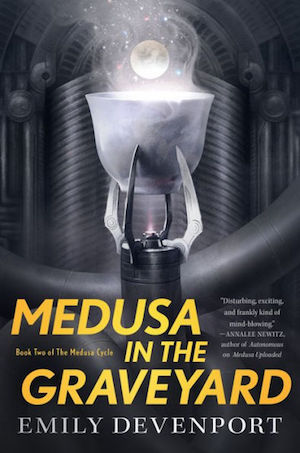
Is there a better setting for a locked-room murder thriller than a generation ship? There’s nowhere to escape to except SPACE, so any assassin’s targets are pretty doomed. But in the case of Medusa Uploaded, you’re definitely going to root for the assassin. Oichi Angelis is a servant on the Olympia. The Olympia’s sister ship, the Titania, exploded with her low-key revolutionary parents aboard, so she was already starting to research the cruelly elitist class policies the Executives force on the resto f the ship. But when one of the Executives jettisons her into space, things get even more personal. Luckily Oichi is rescued by a sentient AI called Medusa, who assists her in her plot to assassinate the Executives…and now that everyone thinks she’s dead, getting up to murder will be considerably easier.
In Book Two of The Medusa Cycle, Medusa in the Graveyard, the Olympia continues its voyage into the not-ominous-at-all Charon system. Because now a delegation has to take the most terrifying step a generation shipper can make: they’ll have to leave the ship. What will it be, for people whose entire lives have been bounded by the walls of their vessel, to touch solid ground?
Buy the Book


Medusa in the Graveyard: Book Two of the Medusa Cycle
The Ark — The 100
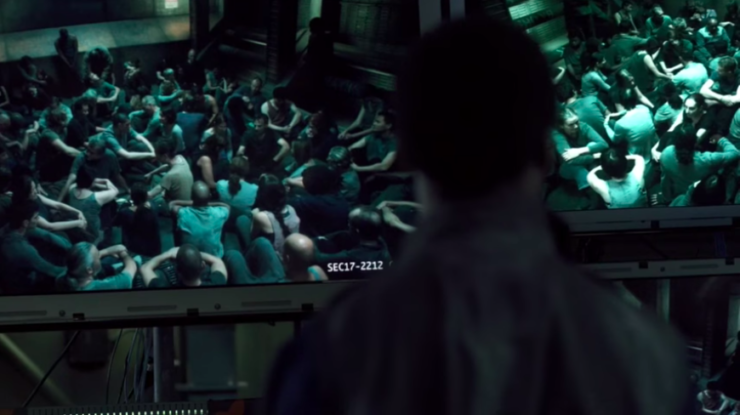
The Ark is the epitome of someone who thinks they want to be in a relationship but doesn’t actually want to put in the work. When humanity escaped the nuclear apocalypse in 2052, it was in a baker’s dozen of separate space stations launched from the United States, the UK, France, Russia, Japan, India, Uganda, and other nations. After a few years of floating past one another, they started to get lonely, which led to fusing a dozen stations (minus rebel Polaris) into one Ark.
Despite whatever good intentions brought everyone together, the Ark managed to be a hot mess for its entire first century of existence. The population ballooned from 400 to 2,400, which severely hampered life support systems. In turn, the governing bodies who ran the Ark had to start instituting population-culling measures including a one-child policy, the punishment of “floating” for treasonous crimes, cutting the oxygen from entire swaths so the rest of the station could breathe a little longer (RIP Section 17), and, oh yeah, sending 100 juvenile delinquents down to irradiated Earth, effectively to their deaths.
This was a case of stronger apart than together, so by the time the parents on the Ark decided to take their chances with their kids on Earth and broke the Ark back into its components—which they then crash-landed on the planet’s surface—it was a long time coming.
LDSS Nauvoo — The Expanse
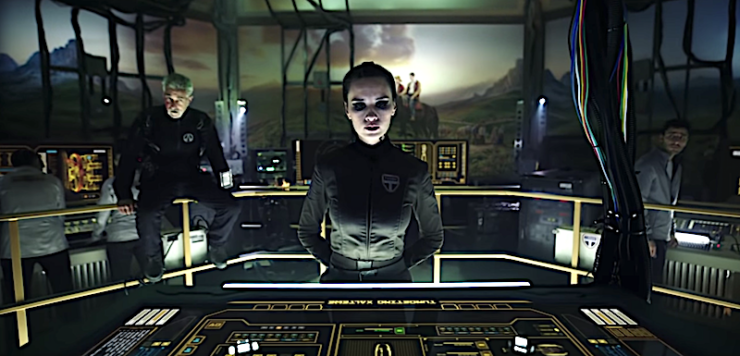
In the world of The Expanse, humanity has spread out across the solar system, and stratified into a system of elitist “Earthers” (who are seen as spoiled brats by all the non-Earthers), Mars colonists (who are tough and hardened from their years of trying to terraform the Red Planet), and Belters (a disenfranchised working class who live on the asteroid belt mining ice and cultivating a vibrant black market). But there’s another group, one who tries to harvest members of all three tiers, and that group is the Mormons. The Mormons have thrived in the future, boasting large numbers, and they have a plan to go on a mission trip toward Tau Ceti, a solar system 12 light-years away that might support life. Knowing that this will be a generations-long journey, the Mormons buy and outfit a gargantuan ship, the LDSS Nauvoo—2,460 meters long, 950 meters wide, and 910 meters deep—with ten levels of civilization including schools, machine shops, gardens, and, a massive room decorated with murals of the Mormon expedition to Salt Lake back on Earth.
Alas, the Nauvoo never gets to go on her mission: She’s repurposed in a desperate attempt to save humanity from an alien threat, and then finds new life as the Behemoth, a battleship for the Outer Planets Alliance.
The Matilda — An Unkindness of Ghosts by Rivers Solomon

At the start of Rivers Solomon’s debut novel, it has been over 300 years since the Matilda launched from the Great Lifehouse—an uninhabitable Earth. In the course of its journey to a near-mythical Promised Land, this vast generation ship has structured itself after the antebellum South: Its inhabitants are segregated according to skin color, with the darker-skinned people forced to labor in the lower decks—one for every letter in the alphabet—so that the white upper-deckers can enjoy well-lit, temperature-controlled, luxury-filled mansions without worrying about blackouts or malnutrition. What’s more, the omnipotent Sovereignty regularly abuses the lower-deckers, blaming their supposed “sins” for keeping the Matilda from its destination. With no protections, and with limited access even to the decks above and below them, those living in the slums know little else beyond their own dialects and customs; it is, as protagonist Aster Grey notes, the closest thing to a nationality.
Due to her status as a doctor, and her mentorship from the powerful Surgeon General, Aster is allowed to move between decks, all the more for her to witness the racist and brutal disparities among the Matilda’s population. But when a discovery in her late mother’s journals draws comparisons to the mysterious death of the Sovereign, Aster has the chance to learn more about Matilda’s inner workings, its power source, and whether there is actually an existence beyond the ship.
Buy the Book


An Unkindness of Ghosts
Command Carriers — Farscape

In the Farscape universe, the term Peacekeeper seems to be a misnomer—all Sebaceans born into the Peacekeeper way of life exist to be soldiers, members of a galactic super-armada that claims to bring peace… but can only manage to do so with war and weaponry. Their command carriers are giant ships that serve as the centers of Peacekeeper fleets. They are filled with crew of 50,000, who work and live on the carriers, even having children who are born and raised there. Training areas on command carriers can resemble planetary conditions with sky, grass and trees, and more organic-seeming terrain. Essentially, a Peacekeeper could live their entire life on the same command carrier if their duties kept them on board. They do require refueling and other maintenance, but command carriers are well suited to the task of housing tens of thousands of individuals, keeping sizable portions of the Peacekeepers fighting forces in motion and at the ready.
Lsel Station — A Memory Called Empire by Arkady Martine

On the fringes of Teixcalaanli space spins a small independent mining station carrying 30,000 souls. Well, 30,000 bodies and about ten times as many souls, thanks to Lsel Station’s long tradition of imagos. Each stationer, upon being assigned their roles as miners, pilots, heritage, and especially the councilors of these departments, is also given an imago-machine: a neurological implant containing the memory-lines of their predecessors. Depending on the job, experience, and imago maintenance, a given imago could stretch back just a few generations, or perhaps a dozen and more. The most optimal imago situations involve the recipient stitching their mind to the memory-line, so that they become a combination of themselves but also their predecessor, who was in turn an assimilation of themselves and the memories who came before.
While the use of imagos are commonplace on Lsel, the practice is highly guarded outside of the station, as its inhabitants realize how barbaric or simply alien the practice might appear to those who go through life with only one consciousness. After all, how could you understand the benefits of experience if you hadn’t been raised with the expectation that your mind and personality would blend with those of your ancestors?
Buy the Book


A Memory Called Empire
Yonada — Star Trek
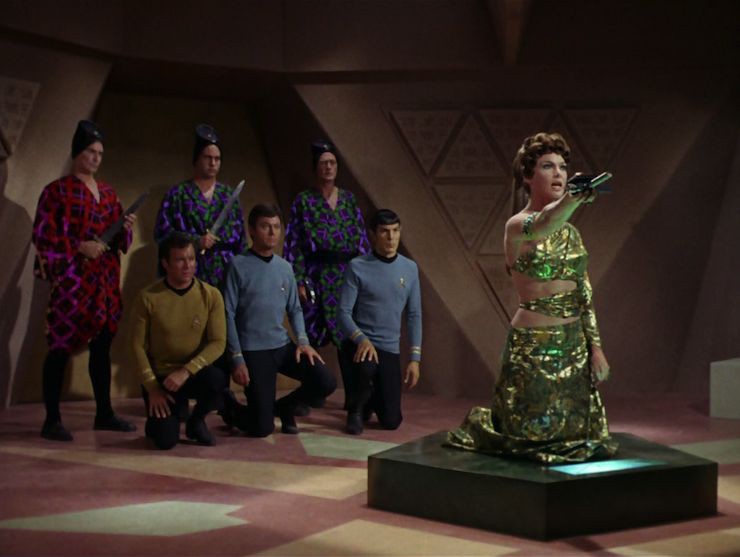
In the third season Original Series episode “For the World is Hollow and I Have Touched the Sky”, the Enterprise has to stop an asteroid that is about to collide with a Federation planet called Daran V. It turns out that said asteroid is actually a ship disguised to look like an asteroid, leading Kirk, Spock, and McCoy to beam aboard and figure out what’s going on. They meet a High Priestess named Natira who calls the ship the “world of Yonada”, a place where they get all of their directions from a mysterious “Oracle” who gives devastating electric shocks to people who disobey its commands. Spock eventually figures out that the Yonadans are descended of the Fabrini, a race that was thought to have died out over ten thousand years ago by a supernova. The Yonadans don’t have any idea about their past, and they don’t know that their world is actually a ship traveling through space. (There’s a whole side plot here where McCoy gets an incurable disease, gets married to Natira, and eventually gets a magical cure for his disease thanks to the Frabini archives, but that’s all pretty much a wash by the end of the episode…) Eventually, Spock finds the control room to this mechanized Oracle and fixes the ship so that it can set the Yonadans down on their own habitable world, but the setup of their ship had many of the denizens fooled for millennia.
Godspeed — Across the Universe by Beth Revis
Amy volunteers to be cryogenically frozen on Sol-Earth in order to wake up on Centauri-Earth, but when she unexpectedly gets thawed, she learns that she has been revived fifty years too early—and there’s no way to put her back in stasis. But even though her unfreezing was half a century ahead of schedule, generation ship Godspeed has nonetheless changed drastically since its first crew lifted off from Earth. The entire population is monoethnic and separated across strict cultural lines according to purpose: the Shippers keep Godspeed running; the Feeders supposedly maintain the ship’s vegetation, but during the Season, they go into a mating frenzy; and the Keepers—that is, the leader Eldest and his protege, Elder—oversee everything. As Amy tries to find out who is unplugging cryo pods and murdering their inhabitants, she unwittingly brings to light the various ways in which past Eldests have kept Godspeed on track.
Buy the Book


Across the Universe












In that vein, but not not a ship, is Lustbader’s Sunset Warrior…
Elizabeth Bear’s Grail trilogy also comes right to mind, as does the Books of the Long Sun by Gene Wolfe.
The Ballad of Beta-2 by Delany comes to mind!
One of my faves, the Axiom from Wall-E.
In Jo Walton’s story, Turnover, the protagonists know they are on a generation ship that is scheduled to land, but have decided that they prefer the ship life.
@3, I read it for the first time a month ago. A beautiful story. My favorite of Delany’s 60s work.
How about the early 1970s Canadian sci-fic series The Starlost? Created by Harlan Ellison and starring Keir Dullea, it featured a multi-generational spaceship with a dead crew on the bridge, and three people wandering from one separate living environment to another in flared trousers and sideburns.
Another Doctor Who candidate: “The Ark”, from 1966, designed to carry humanity’s last survivors to a new home. What was interesting about this story was that it was actually two mini-stories set hundreds of years apart, as the TARDIS crew had to confront the accidential consequences of their first visit.
The two novellas “Universe” and “Common Sense” that make up Heinlein’s ORPHANS OF THE SKY may be, so far as I can figure, the first use of the idea of a starship society.
THE WHORL!!!!!
The Behemoth isn’t a battleship alone. It’s a battleship with a wink and a nod. Literally the first thing said about it is that it was “a jury-rigged piece of crap just as likely to blow itself up when it fires any one of the guns strapped to it.”
An Unkindness of Ghosts is one of the best scifi novels I have read. I got an early review copy originally and the blurb said “a worthy successor to Octavia Butler” which were huge shoes to fill. She filled them. I can’t wait for her next book, The Deep.
How about the Vanguard from “Orphans of the Sky”?
To raise the intellectual level of our program, as Kermit the Frog used to say, I want to mention Harry Martinson’s Aniara.
Elizabeth Bear’s Pinion trilogy – an incredibly detailed and evolved ecology of autonomous systems and generational guilds who slowly uncover the less than benign original intent of builders whilst struggling with their own internecine battles. Breathtaking and beautiful.
What, no mention of Harry Harrison’s “Captive Universe”?
Emily Skrutskie’s Hullmetal Girls is set aboard a whole colony-fleet (with the hard vacuum between the ships used to enforce a caste system –and provide harrowing action sequences as characters have to space-jump from ship to ship).
There’s also the manga/anime Knights of Sidonia (Sidonia no Kishi), set aboard the titular crumbling generation ship. Sidonia is old enough that everything aboard has been patched and reclaimed (even clothes have been passed from generation-to-generation), but not so old that they’ve forgotten their ancient homeworld.
And I’d be remiss if I didn’t mention the SDF-1 Macross (of both Macross and the first generation of Robotech), though the first one arose more out of necessity than choice. Subsequent Macross series have established the existence of deliberate Macross/Megaroad-class colony fleets plying the galaxy (the second and third generations of Robotech also feature mass interstellar migrations [of the Robotech Masters and the Invid], but we only really see the end results).
I will always have a side-eyeing soft spot for Ship, from Frank Herbert’s Pandora novels.
Also, seconding the Starlost. Campy, but hey.
I wonder if Starship UK owes James Blish’s “Cities in Flight” credit for its inspiration. Although not exactly on-point, as everyone knows they’re a “spaceship” and the citizens of the scrappy city Scranton often meet up with bigger, more powerful cities, it was one of my first (if not my first – hard to remember now) encounters with the trope of a self-contained civilization traveling among the stars.
Heinlein’s “Orphans of the Sky” (1941) may have been the first, but another classic is the first novel from Brian Aldiss. It was originally published in the U.K. in 1958 under the title “Non-Stop”, making the climactic realization of the setting a surprise, but was released in the U.S. (in 1959) as “Starship”, giving everything away at the beginning.
I’d mention Ship, the setting for (and the narrator of!) Kim Stanley Robinson’s brilliant novel Aurora, one of the two best generation starship stories ever. (The other, natch, is Gene Wolfe’s The Book of the Long Sun, with its setting of The Whorl, but several people have already mentioned that omission.)
How about the Ship from Rite of Passage?
An environment comfortable enough to make the original crews who brought to colonisers to their worlds from the dying Earth want to stay on board and become a privileged class living off the work of the colonists.
For me I would add Gregory Benford’s Heart of the Comet
I’d add Alistair Reynolds’ “On the Steel Breeze” with multiple generation ships in a caravan with all the intraship and intership relationships and politics that entails. Besides, one of the ships carries intelligent elephants along with the humans and how can you resist that?
Note that while it’s a standalone novel, it makes more sense if you read “Blue Remembered Earth” first.
Good lord, you actually publish Book of the New Sun and don’t mention it here? Fie!! [and a nod to Paul Weimer for noting this first]
Any of the General Systems Vehicles in Iain M. Banks (RIP) Culture novels.
They might not be in the spirit of this piece, since the focus was more on the GSVs themselves as characters in the stories, rather than on the people who lived in them. Still, GSVs are planet-sized starships with, in some cases, billions of people living on them.
@19 thank you for making me not feel crazy in mentioning “Orphans” since, AFAIK, it is, as you said, first of its kind. I’d forgotten about “Non Stop,” that’s a good one too.
@17 I THOUGHT about Ship, but since Ship is more a character in the books than a setting with much of the action happening on the planet with Ship orbiting above it didn’t seem to fit as well. IMO anyway.
How about the Leonora Christine in Poul Anderson’s Tao Zero?
The population is tiny. But they are the only surviving humans in the universe. So the LC should qualify.
the Death Star
@28 it’s not really self contained. More like an aircraft carrier IMO. Do they HAVE hydroponics bays? Never seen anything like that. Supplies come in on ships.
Marrow by Robert Reed. A ship on a huge scale – the size of planet – but still a ship.
Matter by Iain M. Banks
Rendevous with Rama by Arthur C. Clarke
Pushing Ice by Alastair Reynolds
Confluence Trilogy by Paul McAuley
Poul Anderson’s Tales of the Flying Mountains is a fixup framed in a generation ship traveling to Alpha Centauri.
A very small society, but….
SIMON Captain… why did you come back for us?
MAL You’re on my crew.
SIMON Yeah, but you don’t even like me. (beat) Why’d you come back?
MAL You’re on my crew. Why we still talking about this?
[Firefly]
From Becky Chambers’ Record of a Spaceborn Few, the Exodus Fleet and the Exodans should surely be included here.
Not on paper or film, but if you want to give your eyes and imagination a treat check out the art of Paul Chadeisson.
The scale is simply vast and you can easily imagine massive stories taking place even in tiny corners of his ship- and cityscapes.
Iain M Banks did a great thing explaining how his larger vessels could house millions if not billions of people.
For the record, Harlan Ellison hated what was done to his original script for The Starlost, so much so that he refused the use of his name in the credits. He substituted his sardonic pseudonym “Cordwainer Bird” for his name in the credits, a pseudonym Ellison reserved for those occasions when his work was destroyed by ignorant Hollywood types but he couldn’t get out of the contact.
IIRC, Ben Bova wrote a sateical novel based on Ellison’s experiences with The Starlost, and Ellison himself wrote a factual piece about it.
Ditto on “Rite of Passage” by Alexei Panshin. 1968 Nebula award winner, Hugo award nominated 1969
Wikipedia Entry
Arkady Martine’s A Memory Called Empire uses various technologies to make the story believable, and does a very good job of it, but couldn’t the various colonies be planets and not artificial settlements? Sure, but this book is absolutely brilliant in its handling of character politics and culture. Sf is alive!
“The Forever Watch” by David Ramirez, a lucky find while searching for another ark ship book. The story changes direction few times, so if you do not like the starting murder-mystery mode just read along, it will be something different soon (and then something else, and then…). Some reviewers count the changing story as a flaw, but I liked TFW very much.
“The Ark” by Patrick S. Tomlinson, the above-mentioned book I had been looking. This one is more straight-forward murder mystery in space.
Both books feature young societies (compared to a few examples mentioned earlier) – the inhabitants do know they are on a spaceship and their destination. In “The Ark” they probably can see their (future) home from the window… ;-)